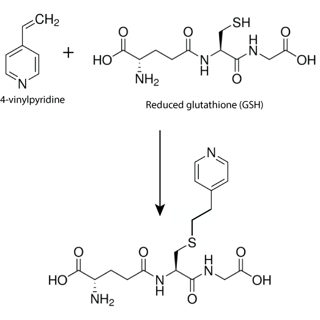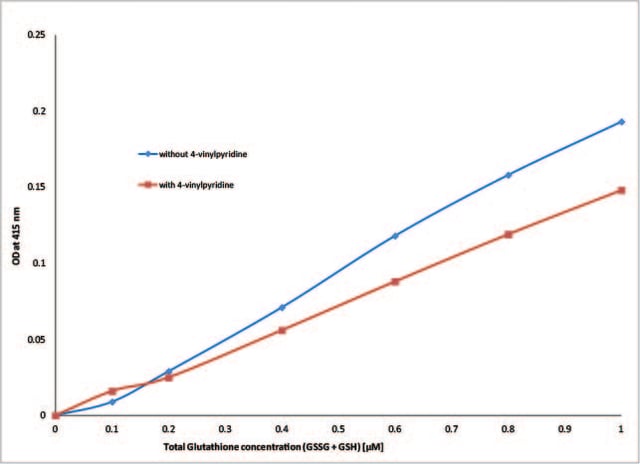4-Vinylpyridine as a derivatizing agent for free thiols and its application in Glutathione assay
Glutathione assay involves quantification of reduced Glutathione (GSH) and Oxidized Glutathione (GSSG) in various organisms or in various tissues, blood samples, plasma, serum or cultured cells. Free thiols such as GSH can be detected by their property of relatively high reactivity compared to other biological molecules. On contrary disulfides such as GSSG does not have any unique property that could be exploited for its quantification. Hence Glutathione disulfide (GSSG) quantification can be done after reducing it to its corresponding thiol (GSH). Thus the most widely adopted methodology for quantification of GSH and GSSG is determination of total GSH concentration, followed by alkylation to remove GSH and then reduction of GSSG and its quantification. GSH concentration in sample can be determined by subtracting glutathione disulfide concentration from total glutathione concentration.
Reduction and alkylation are two key processes involved in thiol quantification. In colorimetric Glutathione assay glutathione reductase reduces GSSG to GSH at the expense of oxidation of NADPH. DTNB (5-5’-dithiobis [2-nitrobenzoic acid) reacts with GSH to form yellow color chromphore, 5-thionitrobenzoic acid (TNB) with absorbance maxima at 415 nm and GS-TNB. GS-TNB is further reduced to GSH and TNB by glutathione reductase and NADPH is oxidized in the process. The glutathione concentration of unknown sample is measured by measuring the absorbance at 415 nm and comparing it with standard curve for GSSG which is plotted every time new for any glutathione estimation.
What is a derivatizing agent?
Derivatization is a process by which a compound is chemically changed to a new compound that has properties suitable for a particular assay or particular analytical method and the agent that carries out this process is called a derivatizing agent.
Mode of action of 4-Vinylpyridine
4-Vinylpyridine acts as a derivatizing agent for GSH in glutathione assay as it alkylates GSH and thus masks GSH leaving only GSSG in sample which is quantified with DTNB (Ellman’s reagent) after being reduced by glutathione reductase to GSH.

There are other alkylating agents used earlier for masking GSH in glutathione assay like N-ethyl-maleimide, 2-Vinylpyride etc. Although N-ethyl-maleimide can mask GSH effectively, it is not preferred for glutathione assay as it inhibits glutathione reductase. Many commercial kits also indicate that although 2-Vinylpyridine does not inhibit glutathione reductase, it still interferes with colorimetric glutathione assay. 4-Vinylpridine has been found to be more efficient in removing GSH and affects the assay marginally. Since, the standards for glutathione assay and the samples are treated with 4-vinylpyridine at same concentrations and same conditions, the marginal negative effect of 4-vinylpyridine is seen in glutathione standards and samples equally and thus treatment with 4-vinylpyridine does not interfere with estimation of glutathione concentration in the samples.

As seen in the figure above, for glutathione assay, concentration of total glutathione is determined by not treating the samples and the standard with 4-vinylpyridine. In this way, the GSSG will be converted to GSH and the existing GSH and GSH made from GSSG is all quantified. For only GSSG quantification samples and the standard are treated with 4-vinylpyridine for an hour before performing glutathione assay and thus GSH is removed and only GSSG concentration is determined.






